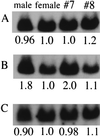The location of Z- and W-linked marker genes and sequence on the homomorphic sex chromosomes of the ostrich and the emu
- PMID: 9539751
- PMCID: PMC22503
- DOI: 10.1073/pnas.95.8.4415
The location of Z- and W-linked marker genes and sequence on the homomorphic sex chromosomes of the ostrich and the emu
Abstract
Perhaps the most striking fact about early Cenozoic avian history some 70 million years ago was the rapid radiation of large, flightless, ground-living birds. It has been suggested that, for a time, there was active competition between these large terrestrial birds and the early mammals. Probably reflecting the above noted early start of Ratitae of the infraclass Eoaves, the presumptive sex chromosomes of their present day survivors, such as the emu and the ostrich, largely remained homomorphic. The signs of genetic differentiation between their still-homomorphic Z and W chromosomes were tested by using two marker genes (Z-linked ZOV3 and the gene for the iron-responsive element-binding protein) and one marker sequence of a part of a presumptive pseudogene (W-linked EE0.6 of the chicken). Their homologues, maintaining 71-92% identities to the chicken counterparts, were found in both the emu (Dromaius novaehollandiae) and the ostrich (Struthio camelus). Their locations were visualized on chromosome preparations by fluorescence in situ hybridization. In the case of the emu, these three marker sequences were localized on both members of the fifth pair of a female, thus revealing no sign yet of genetic differentiation between the Z and the W. The finding was the same with regard to both members of the fourth pair of male ostriches. In the female ostrich, however, the sequence of the gene for the iron-responsive element-binding protein was missing from one of the pairs, thus revealing the differentiation by a small deletion of the W from the Z.
Figures



References
-
- Ohno S. Sex Chromosomes and Sex-Linked Genes. Heidelberg: Springer; 1967.
-
- Becak W, Becak M L, Nazareth H R S, Ohno S. Chromosoma. 1964;15:606–617. - PubMed
-
- Sibley C G, Ahlquist J E. Phylogeny and Classification of Birds. New Haven, CT: Yale Univ. Press; 1990. pp. 810–870.
-
- Benirschke R J, Sekulovich R E, Risser A C. Chromosome Information Service. 1976;21:13–14.
-
- Ansari H A, Takagi N, Sasaki M. Cytogenet Cell Genet. 1988;47:185–188. - PubMed
Publication types
MeSH terms
Substances
Associated data
- Actions
- Actions
- Actions
- Actions
- Actions
- Actions
LinkOut - more resources
Full Text Sources
Other Literature Sources

